
The Art of Environmental Textiles by Claudie Jongstra
Dutch artist Claudie Joongstra creates wall coverings from fabric. Her techniques differ somewhat from the rest of the artists. While other artists take their materials from handicraft stores or wholesalers, ecologist Joongstra uses materials from her farm and creates her own. Her work has been featured in many publications. of museums and galleries.
Who is Claudie Jongstra?
Claudie Jongstra was born on February 6, 1963 in the Netherlands, and she attended the Utrecht School of Art for Fashion Design, from which she graduated in 1989. Her fascination with felting wool appeared in 1994, and she mastered it, and from there she created various works of art and installations, and then established her own studio under the name Studio Claudie Jongstra in 1995.
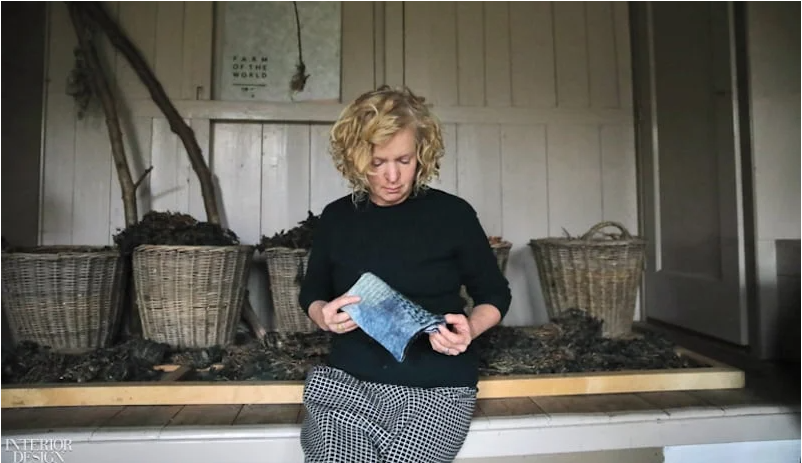
Actress Claudie Jongstra
Source material from Claudie Jongstra Farm
Jungstra is an advocate of the environment, and is keen to provide the materials she uses in environmentally friendly ways. The studio she owns is located on her farm in Friesland, the Netherlands, where she raises and grazes a herd of Drenthe Heath sheep, one of the sheep known in the Netherlands. This rare curly-haired sheep provides valuable, sustainable wool, and Joongstra stresses that "if you're serious about a material, you need to understand its connection to the environment."
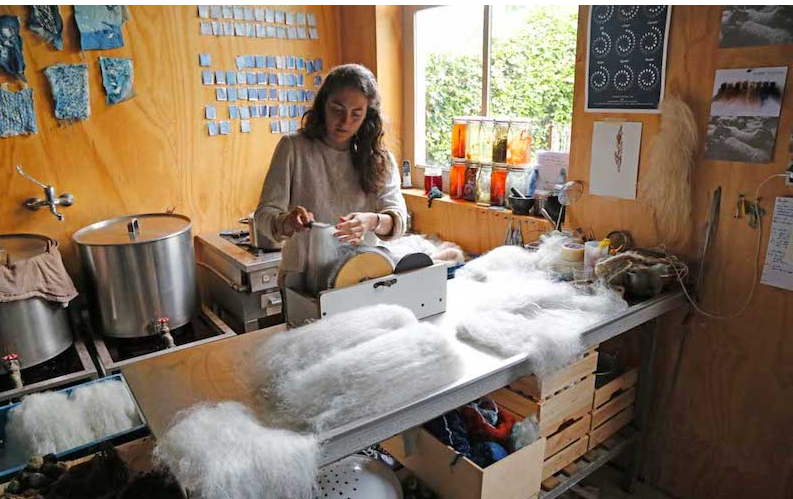
Artist Claudie Jongstra works with wool in the studio
Jongstra also grows many different kinds of plants on her farm, and these plants are used to extract organic dyes which she uses to dye wool, and these plants include chamomile, indigo, valley (yellow flower), madder, and many others...
In her garden, Jungstra has set up a laboratory and classroom for students who are eager to learn more about these subjects. Many students from all over the world compete to join the class and learn about the experience that Jongstra offers.
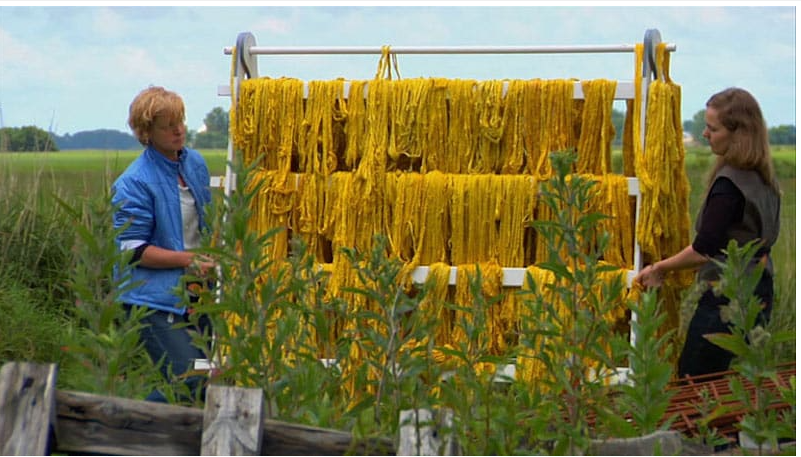
Claudie Jongstra and her helper on her farm
Claudie Jongstra's work around the world
Claudie Jongstra's work is spread all over the world and is in the permanent collections of the New York Museum of Modern Art, the Smithsonian Museum of Design, the Rhode Island Art Museum of Design, the Stedelijk Museum, and the Victoria and Albert Museum. And other museums... Her works are used in the decorations of many private institutions such as the Amsterdam Public Library, restaurants in Rotterdam and Philadelphia, the Dutch Embassy in Berlin, the Prime Minister's residence in The Hague, the United Nations in New York... and other places.
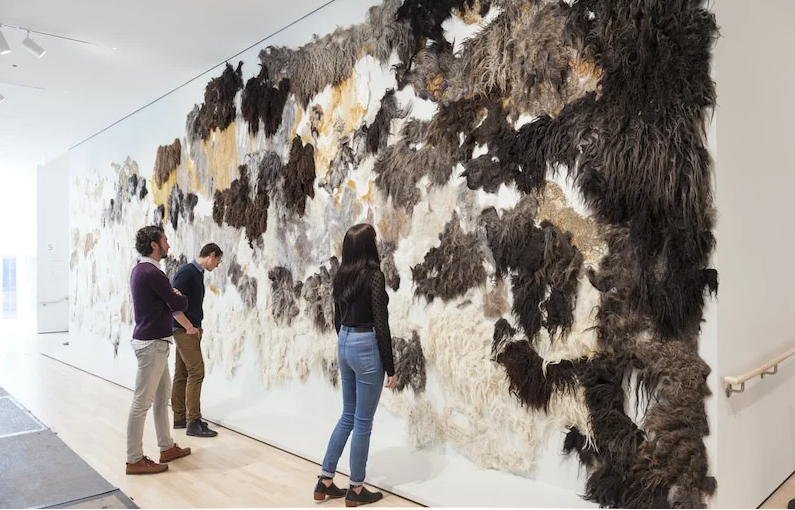
"Aarde" by Claudie Jongstra, at the Museum of Modern Art, San Francisco
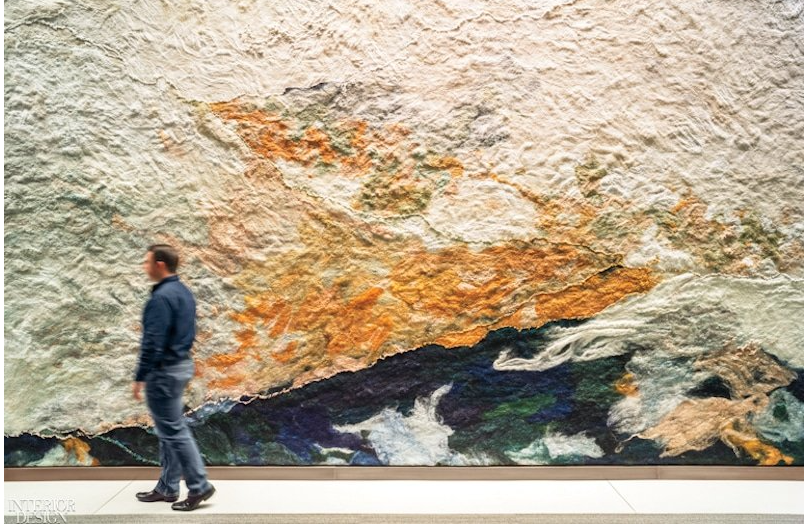
Transformational Fields by Claudie Jongstra
Working on her farm to this day as a textile artist, Jongstra launched her latest work, Woven Skin, an impressive tradition in New York City, in which a mix of 60 pieces of wool is displayed against the background of a disharmonious soundtrack, and the screen plays a conversation about ways to Sustainable production and supply of textile materials.

"Woven Skin" by Claudie Jongstra
In conclusion, the art of hand weaving, especially textile hangings, plays an important role in the renaissance of textile arts and plastic paintings, which in turn reflect the self-vision of plastic weavers when conveying their feelings and emotions, through the aesthetic and functional values that these works contain that make them an important source of plastic arts. inspiring.
Share
We are here to help everyone erase their criminal records , DUIs , bad driving records and other criminal records needed without any mishap .We have the Real registered drivers license, Illinois state id requirements, Illinois id requirements , what do you need to get your license Illinois how to get a new drivers license illinois , Fake Malaysian passport , credit card hack software, Fake UK Passports , Fake Bank Statement , Fake bank statement for loan , How To Get A Driver’s License in Ontario And British Columbia and good quality Fake Driver License will be verify from any other country with no problems involved, meanwhile with the camouflage quality Fake drivers License , non of your biometric details will be under the government system, but it can not be detected as fake with naked eyes. We also help people with DUI and other criminal records erased without any mishap , how to get your DUI erased is a problem which is solved here.
Now email us today at our E-mail address at: { qualitydocuments9@gmail.com }
Visit our website on : noveltydmvexperts.com
Thanks and waiting to Hear from you soonense for USA , UK , Canada which is unregistered. Real Estate License , How To Get A Fake Drivers License That Works From The DMV . Belgian driving license , Irish driver License , Fake drivers license nsw , How to spot a fake id Australia .With the Drivers License , all your biometric details as given from birth or How to Easily Order for a fake driver License online from the comfort of your home . Meanwhile in UK , you can easily obtain a Fake Driving Licence UK Online without any driving test. Welcome to Novelty DMV Experts Best Producers of High Undetected Drivers License . We produce two types of documents qualities. Both real and fake drivers License . We also offer quality Irish Drivers License for Irish Citizens.
Where to easily obtain Registered Passports , IDs , ssn , drives license that works from the database system for various Countries . We also provide , Fake birth certificate with raised seal . you can also get fake divorce papers , Forged Passports , False Passport , Fake UK Documents , Valid German driving Licence , Welcome to Octapustickets Group of Experts Best Producers of High Undetected Drivers License . We produce two types of documents qualities.
We have the Real registered Fake birth Certificate, Fake Divorce papers , and good quality Fake Driver License will be verify from any other country database system with no problems involved, meanwhile with the camouflage quality Fake drivers License , non of your biometric details will be under the government system, but it can not be detected as fake with naked eyes, except with the use of machines.
We also help provide easy methods on How to become a real Portuguese citizenship smoothly. the use of machines. We also help you Clear your Criminal record from any countries court system or criminal records database system.
Download the Telegram APP and Text us at : OCTAPUSTICKET for more informations an orders. email us today at our E-mail address at: { octapusticketsgmail.com }
Visit our website on octapustickets.com
Thanks and waiting to Hear from you soonense.
Recover your lost money, bitcoin etc with this reliable hacker “Evans Webroot” who did a great job for me. You can testify to yourself as soon as you work with him. contact him on " Webroothacker @ gmail com
I was recently scammed out of $53,000 by a fraudulent Bitcoin investment scheme, which added significant stress to my already difficult health issues, as I was also facing cancer surgery expenses. Desperate to recover my funds, I spent hours researching and consulting other victims, which led me to discover the excellent reputation of Capital Crypto Recover, I came across a Google post It was only after spending many hours researching and asking other victims for advice that I discovered Capital Crypto Recovery’s stellar reputation. I decided to contact them because of their successful recovery record and encouraging client testimonials. I had no idea that this would be the pivotal moment in my fight against cryptocurrency theft. Thanks to their expert team, I was able to recover my lost cryptocurrency back. The process was intricate, but Capital Crypto Recovery’s commitment to utilizing the latest technology ensured a successful outcome. I highly recommend their services to anyone who has fallen victim to cryptocurrency fraud. For assistance, contact Recovercapital@cyberservices.com Capital Crypto Recover on Telegram OR Call Number +1 (336)390-6684 via email: Capitalcryptorecover@zohomail.com

































